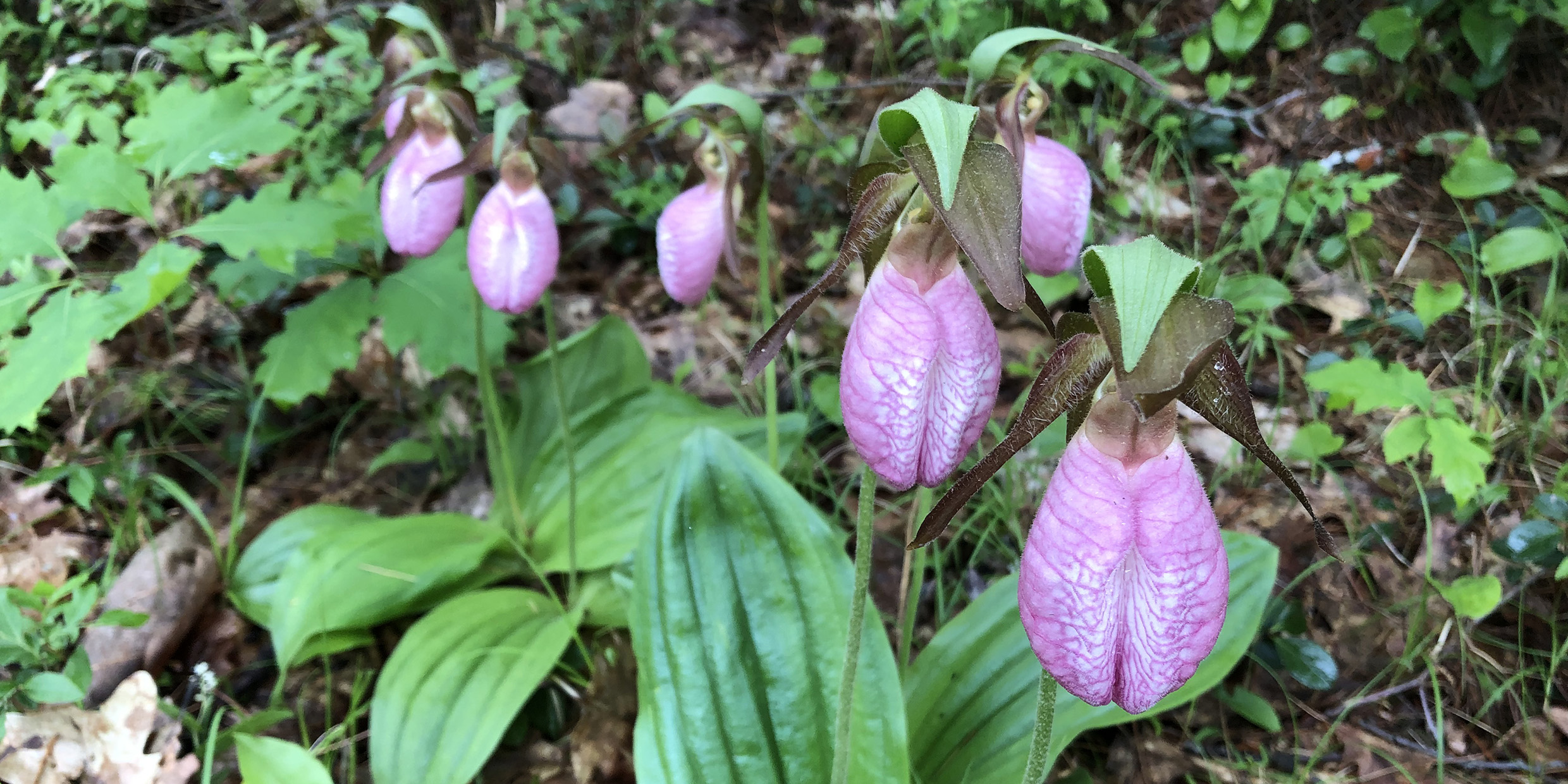Originally published 8 June 1987
Lady’s slipper. Moccasin flower. Squirrel shoes. The scientific name of the plant is Cypripedium, which is Greek for “slipper of Venus.” The early French explorers of North America called it le sabot de la Vierge, “the sabot of the Virgin”; a sabot is a wooden shoe worn by peasants in France.
Try as I might, I cannot see a shoe or a slipper in this plant. Perhaps, with a stretch of the imagination, the inflated hanging sac of the flower bears some resemblance to the wooden shoes of peasants I have seen in paintings by Van Gogh. But no matter — the pink lady’s slipper is the most spectacular wildflower of New England and this is its season.
The lady’s slipper is a plant that looks more appropriate to a tropic forest or an orchid-fancier’s hothouse than to the New England woods. It is irresistibly gorgeous, and in a less environment-conscious time it was in danger of being picked out of existence. I have among my books a wildflower guide published in 1917. “It is becoming rarer every year,” says this guide of the pink lady’s slipper, “until the finding of one in the deep forest, where it must now hide, has become the event of a day’s walk.”
The lady’s slipper was once so rare in our area it was considered an endangered species. In some states the flower is protected by law, but it is no longer rare. In one pine woods near my home the plants are so numerous that it is difficult to take a step without crushing a flower underfoot. The lady’s slipper appears to be making a comeback. Year by year I see more and more of these wild orchids in the woods.
Designed for success
As a family, the orchids are successful; they include more species than any other family of plant. Most orchids are natives of the tropics, but the pink lady’s slipper of New England may give us a clue to the family’s success: It is ingeniously designed to compel pollination by insects — typically bees — and to guard against self-pollination.
Self-pollination in plants produces a seed that is genetically almost identical to the parent. When the pollen of one plant makes its way to a different plant it is called cross-pollination. Cross-pollination mixes genes, and makes it more likely that offspring will differ from parents. As Darwin was the first to note, cross-pollination may give rise to hardier species of plants that are better able to adapt to their environment.
The blossom of the lady’s slipper fairly forces cross-pollination. There are two ways for an insect to enter the flower: through the long, inward-curving slit at the front of the sac, or through two little holes at the top of the sac that are hidden by petals. Attracted by color or scent, the insect invariably enters at the front, and soon discovers it has passed through a one-way door into a voluminous chamber, lush with nectar but with no obvious exit. If the insect persists in its explorations, it will find its way toward the two escape holes at the top of the sac. Forcing its way upward through a narrow passage toward freedom, the insect must first encounter the female part of the plant, the stigma, which is equipped with tiny bristles, like a lint-brush. The brush removes from the body of the bee whatever pollen it has carried from another lady’s slipper.
Free and undaunted
But escape is not yet complete. The bee struggles on toward one of the small round exits, where a male part of the plant, an anther, almost blocks its way. Forcing passage, the bee becomes covered with pollen. Free at last, it is ready to pollinate whatever plant it visits next, although one wonders why, after so much trouble, it has not learned to leave well enough alone.
There is no way, in this system of one-way doors and tunnels lined with forward-pointing bristles that the insect can get to the male part of the flower before the female part. Self-pollination is virtually ruled out by architecture.
I have read that a large bumble bee sometimes finds escape through the flower’s narrow pollen-retrieving/pollen-supplying passage impossible. The trapped bee has two alternatives: to bite its way out through the side of the sac, or (as my early guidebook says) “to perish miserably in its gorgeous prison.” I have looked into the gorgeous sacs of dozens of lady’s slippers hoping to find some poor bumble bee so interred, so far without success.
Once established — and if unpicked — the lady’s slipper seems to be reasonably hardy. There is one particular plant that I have returned to every year for the past five years: It is a solitary snow-white lady’s slipper, alone in a woods with 10,000 of its pink cousins. Each spring when I know the plants are in bloom, I make my way to the place in the deep woods where this marvelous plant flourishes. And this year, it was there again. Still white; still alone.
I know that my white lady’s slipper is not unique. The guidebooks all note the existence of a rare white variant of the plant. In his journal, Thoreau makes special mention of finding a white lady’s slipper among the pinks. And I have heard from other people who have white lady’s slippers in their woods. But in my neighborhood I have seen only this one white plant. It has not multiplied, but it has endured.
If lady’s slippers are protected by law, then the penalty for picking my solitary white flower should be incarceration without parole. But I’m not taking any chances. I have kept its location in the deep forest — “where it must now hide” — entirely to myself. Only bees are welcome.


